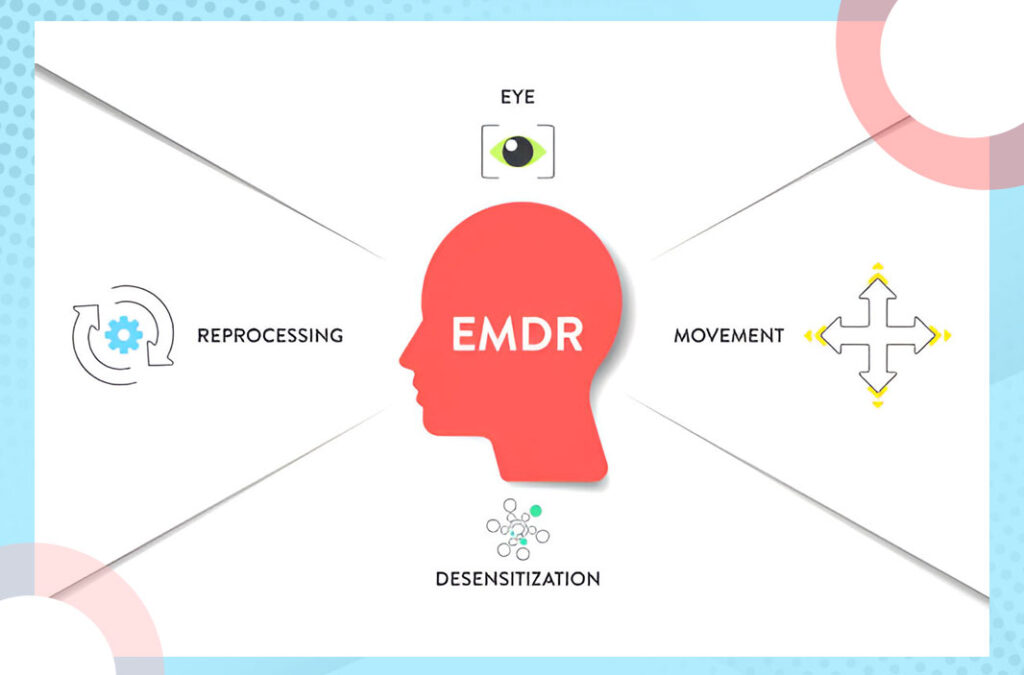Don’t you wish moving on from a painful experience was as simple as pressing a button?
Although it may seem extreme, EMDR therapy is highly effective in helping the brain rehabilitate its ability to process traumatic memories so they no longer pose a threat to your emotions or actions.
Unlike conventional therapies that focus on speech, EMDR therapy inherently utilizes eye movements alongside boundaries to alleviate distress while replacing debilitating self-beliefs with more affirming, self-compassionate ones.
This modality is particularly effective for distressing memories, trauma, and anxiety as it works on healing from within. Knowing how it works brings clarity, hope, and the tools needed to take control of your life.
Continue reading to learn about the 8 steps the EMDR therapy process entails and understand how each phase propels you toward achieving emotional autonomy.
1. History-Taking and Treatment Planning
In the beginning, your therapist will take time to understand your history, paying particular attention to details that could have caused emotional pain or trauma.
During this phase, you will locate target memories, events, or experiences that negatively impact your mental or emotional health. You will formulate a plan together, considering your objectives and symptoms.
This plan sets the groundwork for the work to be done. If a good connection has been established, patients are able to trust that it will support their readiness and confidence as deeper phases of EMDR therapy are approached in later stages.
2. Preparation
After the initial preparations have been made, you’ll start the pre-EMDR session steps. During this step, your therapist will explain the EMDR therapy process to you, along with what you should expect during the sessions.
Practical grounding skills will also be taught, such as deep breathing or imagining a calm and safe place, aiding people in maintaining an even emotional keel throughout the reprocessing of painful memories.
Learning these skills first ensures greater resilience when distress is encountered. This phase is designed to make sure that you feel safe and supported before beginning the approach of processing difficult memories, which prepares you for deeper healing.
3. Assessment
Since you have already been provided with some coping strategies, the next step will be to focus on a specific memory now. In this step, you select the image that encapsulates the memory, the underlying negative belief accompanying it (for example, “I’m not safe”), and the feelings associated with it, both emotionally and physically.
You also select a preferable belief that you would rather hold: “I am safe now,” for example. Then, you rate your emotional disturbance and how strongly you believe the positive thought. This enables the mind to reprocess by preparing it to focus on the memory and activate emotions tied to it.
4. Desensitization
With the target memory activated, you begin EMDR’s core phase—desensitization. In this step, you will attend to the traumatic memory while doing a form of bilateral stimulation like eye movement or tapping. While this is done, thoughts, images, and feelings can come up spontaneously.
You will observe and communicate these to your therapist, who will lead you through brief sets of stimulation. Eventually, you will notice that the memory is becoming less troubling.
Here, the aim is to numb your emotional response so the memory becomes neutral, not emotionally charged. While this change occurs, your brain begins to reprocess the event in a healthier manner.
5. Installation
Once your emotional distress is lessened, your therapist will assist you in concentrating on the positive belief you identified earlier. This is the part of the procedure aptly referred to as installation.
Now that the memory ceases to control you, you will bolster the new adaptive belief “I did the best I could,” “I am strong,” and so forth. Through bilateral stimulation, your therapist will aid you until the belief is felt and it is indeed true.
This phase is important because it replaces old thoughts with new, unrestrictive, and empowering beliefs. Consequently, enhanced perspectives that aid in supporting and fostering your recovery, healing, and growth are adopted.
6. Body Scan
Upon embodying the newly accepted positive belief, you’ll now take a moment to focus on your body. This step, called the body scan, seeks to find any remaining physical discomfort associated with the memory.
If there are some sensations of any sort, such as tightness and pressure, which lead to discomfort, you will use the same method of bilateral stimulation to process them. Trauma is often held in the body, so the purpose of this scan is to ensure healing is not just psychological but somatic as well.
Ultimately, your body goes into a state of serenity and relaxation, signaling that the perception of the memory is free of harmful emotional responses.
7. Closure
In cases where the session did not complete full processing, the participant will not leave feeling frazzled. You will go using the calming strategies you implemented earlier to an emotionally safe place.
Your therapist will take you back to your safe place visualization and aid you in deep breathing. Alongside using emotion useful for managing emotional processing, you will discuss how to cope in the intervals between sessions.
Despite still experiencing distress, you will feel stable and supported after the session once blocked emotions have been released. This approach ensures that participants do not leave feeling loaded with unresolved emotional stress as they resume their daily activities.
8. Re-evaluation
During your next appointment, you and your therapist will work on the memory to assess whether or not the amount of distress remains low while the positive belief still feels true.
If necessary, additional work is done. This evaluation helps maintain the progress achieved and informs subsequent sessions, deepening emotional recovery while enhancing resilience.
Conclusion
Familiarity with the eight stages of EMDR therapy puts you one step closer to healing. Congratulations; now, you have a roadmap to transform pain into power.
As you journey through EMDR with the right guide and support, you will restructure your emotional wiring, relinquish what is unjustly weighing you down, and shift into a life of clarity, confidence, and calm.







